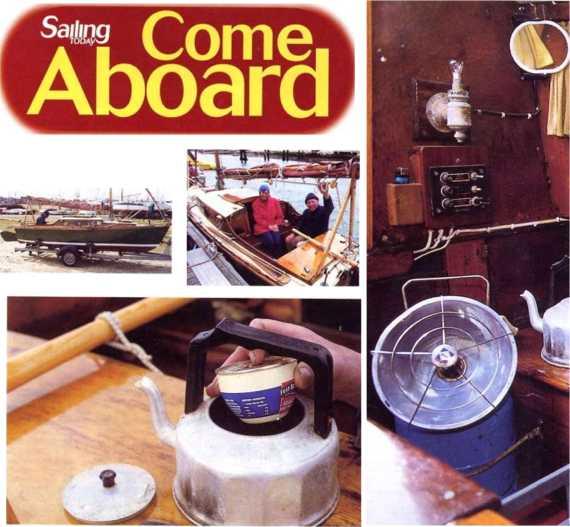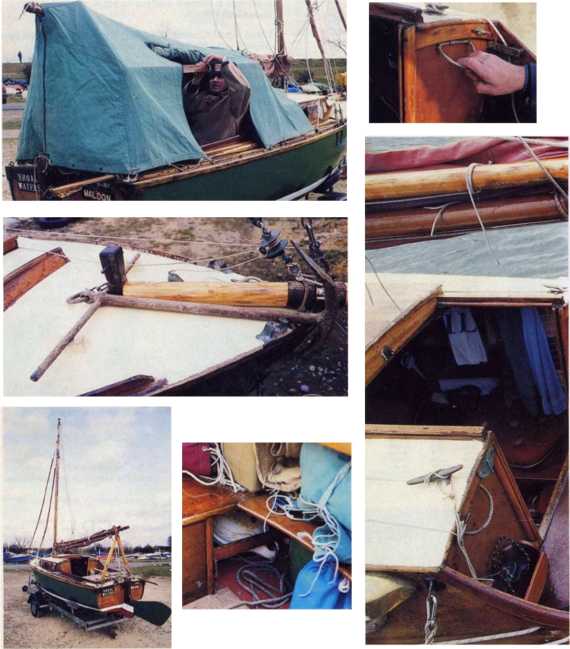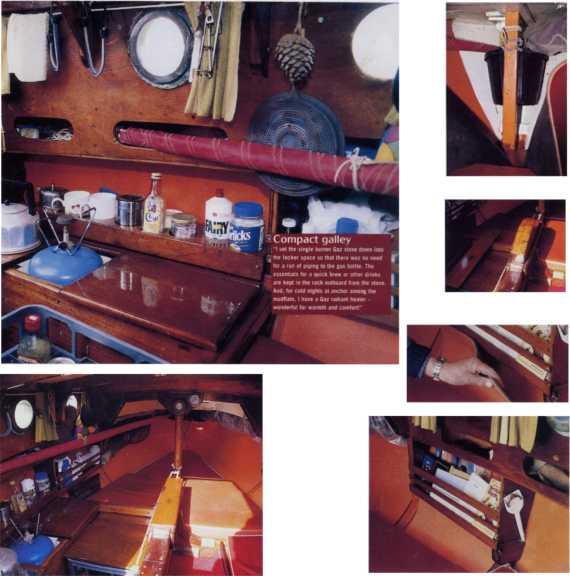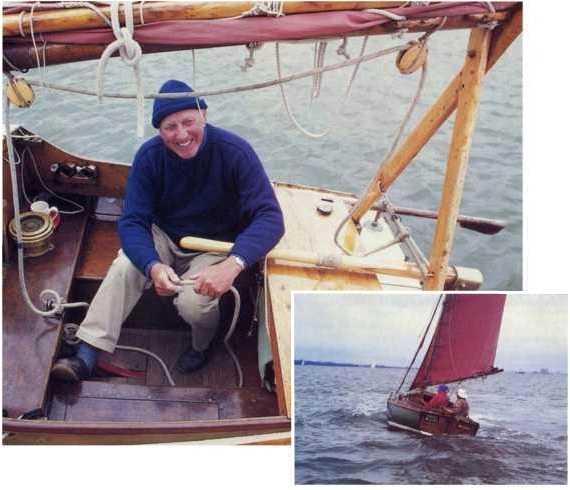Article in Sailing Today June 97
Charles Stock and Shoal Waters are synonymous with small boat cruising. Join us aboard to discover her special modifications.
Shoal waters is a boat apart, and her owner, Charles Stock, is similarly a one off. Together they make a partnership that has lasted since the 1960s and has seen them cruising together, year after year, to and fro across the Thames Estuary, covering thousands of miles each season. To date, the total is close to 60,000 miles.
Their numerous voyages have reached the headwaters of the Thames, taken them into the Broads and seen them lying to an anchor in the old barge refuges among the East Coast sandbanks. And it’s all been done without an engine; just patience and working the tides in, around and across the banks and swatchways.
Based on a hot moulded Fairey Falcon 16ft hull, Shoal Waters, with her gaff cutter rig and centreplate, has proved an ideal boat for both singlehanded and family cruising with Charles wife and children, and more recently, grandchildren.
She is an object lesson to us all, and proof that you don’t need high finances or a fancy new boat to get some real fun out of cruising in a simple way.
“Compared with the backpacker, the mountaineer and those who pitch a tent from canoes or cycles, the chap with the pocket cruiser has riches galore; almost unlimited food, spare clothing, books and other comforts. It’s all in the mind.”
That’s the opinion of Charles Stock and he is absolutely right. Charles’ wife, Joy, takes a pragmatic view of small boat cruising and declares that she approves of it if only for the very simple reason that “there’s much less housework, you know.”
Cooking in the kettle.
“It’s the ideal place for cooking steak-and-kidney puddings while underway. Honestly! It makes a terrific warm and filling meal. I bring them to the boil, let them stand for 10 minutes, bring them back to the boil again, leave for five minutes and then open them carefully. It works a treat. The empty tin fits the hand perfectly for reaching under the boat and scraping off barnacles. I haven’t used any antifouling for years.”
Under the canopy.
“The boom tent fits over the Broad-style slats and provides extra space –like a second cabin – when setting down for the night. It is tapered forward to minimise windage when anchored in gale conditions. For hot sunshine, I have another flat awning that gives good shelter.”
Grab handles.
“I fitted rope grommets on either side of the companion way to act as grab handles for the helmsman in rough conditions.”
Anchor stowage.
“my fisherman anchor stows with the shank and stock flat on the deck and the flukes almost follow the line of the stem, so it’s virtually out of all ahrms way and yet ready for instant use.”
Ready to launch.
Shoal Waters sits on her trailer, looking splendid in her new paint and varnish. “The scissors boom crutch works very well, but you do have to mind your fingers!”
Cockpit stowage.
“It’s all open for access, but everything stays in place and is ready to hand. In this area I can fit the cockpit covers, fenders and warps.”
The tiny cockpit.
“The advantage of a tiny cockpit is that everything falls to hand. The topping lift, which doubles as a lazyjack, cleats to starboard of the companionway and the headsail cleats on the bridgedeck and binoculars stow on the port bulkhead across from the binnacle. The centreboard, which doubles as an echo sounder in light airs, has its hoist cleated below the bridgedeck.”
Compact gallery.
“I set the single Gaz stove down into the locker space so that there was no need for a run of piping to the gas bottle. The essentials for a quick brew or other drinks are kept in the rack outboard from the stove. And, for cold nights at anchor among the mudflats, I have a Gaz radiant heater – wonderful for warmth and comfort.
Lining the hull for warmth.
“Plywood can be pretty cold stuff to lie against when going to sleep, so I have lined the hull with sheets of the closed cell foam that backpackers use for sleeping mats. On the starboard side, the cabin side is extended down below the sidedeck to give a reinforced girder round the hull where it is weakened by the cabin trunk. It also makes a good hand stowage above the bookcase. I’m pleased too with the holder for the dividers, which has saved me from stabbing my fingers many times!”
Maximum space down below.
According to Mrs Stock, “The great advantage of small boat cruising is that there’s almost no housekeeping to do. It’s quite literally ‘a place for everything, and everything in its place’. The centreboard dominates the cabin, dividing it in two, but there’s good sitting room and plenty of space in the galley.”
“Up the forepeak,” Charles continues, “you can see the Samson post stepped properly on the keel. The black bucket is where the chain stows. It has a rope lashing at the bitter end in case of emergencies. A curved top is put over the centreboard case to let it kick up at sea, but in port it has a flat top.”
Cockpit layout.
“The cockpit is purposely tiny and is ideal for one person but is just big enough for two. Everything is to hand and you can easily see forward over the cabin top while sitting comfortably on a cushion. Shockcord lines on the tiller can be adjusted to steer the boat for short periods while checking the chart. I don’t like self-steering because the boat will sail on if you fall overboard, while a boat with her helm free will mostly tack, heave to and wait for you. Lives have been saved by this.”





